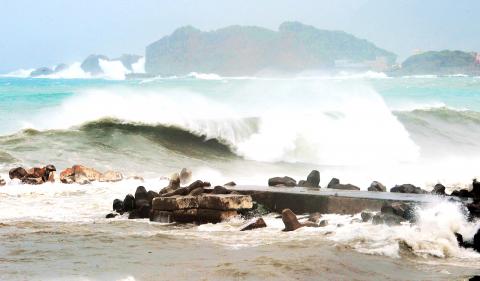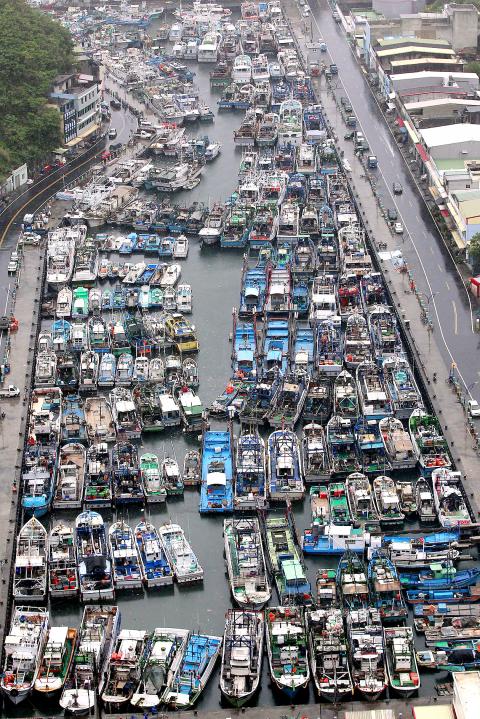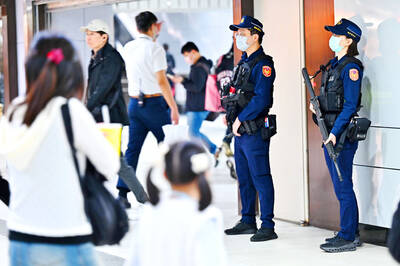Heavy rainfall brought by Tropical Storm Trami disrupted transportation systems yesterday, causing hundreds of people to evacuate their homes and triggering landslides in some parts of northern Taiwan.
At press time, the only injury reported by the Central Emergency Operation Center was that of a 33-year-old Taipei woman surnamed Su (蘇), who suffered a minor injury falling off her motorcycle on Tuesday night. She checked out of the hospital early yesterday morning.
Nearly 1,400 residents of New Taipei City (新北市) and Hsinchu, Miaoli and Hualien counties were forced to evacuate their homes because of the storm.

Photo: Lo Pei-der, Taipei Times
As of 4pm, 195 inbound and outbound flights at Taiwan Taoyuan International Airport had been canceled, about 38 percent of the airport’s daily flights.
The Taiwan Railways Administration canceled all express train services between Taipei and Hualien between 1pm yesterday and 12am today.
The Pingsi (平溪) branch line and the Alishan Forest Railway services were suspended at 1pm. The operation of the Jiji (集集) branch line was suspended at 6:30pm.

Photo: Pichi Chuang, Reuters
Taiwan High Speed Rail Corp (台灣高鐵) yesterday canceled all the express trains after 5pm, but kept the slower service trains that stop at every station running as usual. Passengers were able to sit anywhere in economy class cars without having a reserved seat.
The Central Weather Bureau (CWB) warned that Trami could bring a massive amount of rain to the mountainous areas in central Taiwan, including those in Greater Taichung, and Nantou and Chiayi counties. Each area could see accumulated rainfall of more than 1,100mm, it said. An equal amount of rain could also fall in the mountainous areas of Greater Kaohsiung and Hsinchu, Miaoli and Pingtung counties.
Chen Yi-liang (陳怡良), head of the bureau’s forecast center, said the radius of the storm had reached northern Taiwan and would bring heavy rainfall nationwide. He said that the bureau had also detected strong wind in Cigu District (七股) in Greater Tainan and Wuci District (梧棲) in Greater Taichung, with the wind force reaching levels 8 to 9 on the Beaufort scale.
The bureau also warned that the storm could produce “cloudbursts” — more than 100mm of rain per hour — in some areas.
As of 5:30pm, the center of Trami was 180km northeast of Taipei, with its radius expanding to 180km. It was moving west at 25kph.
The bureau forecast the center of the storm would cruise through the sea north of Pengjia Islet (彭佳嶼) as it heads toward China’s Fujian Province.
This means that Trami is not a typical northwest typhoon, which have caused severe flooding in the past, it said.
The bureau defines a northwest typhoon as one where the center of the storm moves from the sea off the east coast of Taiwan to the waters between Keelung and Pengjia Islet, generating a northwesterly wind that can bring heavy rainfall to the northern and central regions of the island. Because the direction of the wind forms a right angle with the coastlines in these two regions, it is difficult for the overflowing rivers to discharge into the sea.
As of 6:30pm, Niaozueishan (鳥嘴山) in Hsinchu County’s Jianshih Township (尖石) was leading the nation in accumulated rainfall over the past two days with 537mm. Meihua (梅花), also in Jianshih, has seen the second-highest accumulation, with 461mm. Anbu (鞍部) on Yangmingshan was ranked third, with 414mm.
Chen said that Trami is expected to move away from Taiwan proper by early this morning if its speed remains unchanged, but that heavy rain in central and southern parts of the nation would continue after the storm leaves.
“Rain in these two regions is expected to continue for some time, possibly until Friday morning,” he said.
President Ma Ying-jeou (馬英九), who returned home early yesterday from his trip to the Caribbean and Paraguay, urged all local government heads to take extra precautions.
Ma said Taipei should strengthen its anti-flooding measures as Trami was following a path similar to that of Typhoon Nari in 2004, which caused serious flooding in the city.
Taipei Mayor Hau Lung-bin (郝龍斌) said the city has prepared enough sandbags and enhanced flood-prevention barriers in mountainous areas and low-lying areas to prevent serious flooding.
According to Taipei’s Disaster Response Center, the heaviest accumulated rainfall in the city was on Yangmingshan, where more than 300mm had fallen since Tuesday night. While there were several incidents of rainwater accumulation, no flooding was reported in the city.
Yeh Chun-hsin (葉俊興), a division chief in Taipei’s Fire Department, said that about 2,000 households in Zhongshan District (中山) lost power, but the Taiwan Power Co (台電) had fixed the problem.
Hau inspected the Zhitan Water Treatment Plant near the Feitsui Reservoir (翡翠水庫) to ensure that the turbidity of water is at a safe level.
The plant, which began operations in June, is the city’s sixth water treatment plant. Hau said the plant will help ensure that the reservoir continues to offer clean water to the 6 million residents of Taipei and New Taipei City (新北市).
When asked about his administration’s decision to cancel work and school yesterday despite the lack of heavy rains or strong wind, he said the decision had been made in tandem with New Taipei City and Keelung based on the weather bureau’s forecast at 9pm on Tuesday night.
“The forecast suggested that the rainfall would reach 350mm today, and wind gusts would be reach more than level 10, which meets the criteria for school and work cancelation,” Hau said.
“It is important that we take precautions and do not overlook Trami’s power,” he said.
The cities agreed in June last year to make joint decisions on when to cancel school and work days for typhoons or tropical storms to avoid inconveniencing people who commute between the cities.
All three cities said today would be a regular working/school day.
Additional reporting by CNA

TRAGEDY STRIKES TAIPEI: The suspect died after falling off a building after he threw smoke grenades into Taipei Main Station and went on a killing spree in Zhongshan A 27-year-old suspect allegedly threw smoke grenades in Taipei Main Station and then proceeded to Zhongshan MRT Station in a random killing spree that resulted in the death of the suspect and two other civilians, and seven injured, including one in critical condition, as of press time last night. The suspect, identified as a man surnamed Chang Wen (張文), allegedly began the attack at Taipei Main Station, the Taipei Fire Department said, adding that it received a report at 5:24pm that smoke grenades had been thrown in the station. One man in his 50s was rushed to hospital after a cardiac arrest

SAFETY FIRST: Double the number of police were deployed at the Taipei Marathon, while other cities released plans to bolster public event safety Authorities across Taiwan have stepped up security measures ahead of Christmas and New Year events, following a knife and smoke bomb attack in Taipei on Friday that left four people dead and 11 injured. In a bid to prevent potential copycat incidents, police deployments have been expanded for large gatherings, transport hubs, and other crowded public spaces, according to official statements from police and city authorities. Taipei Mayor Chiang Wan-an (蔣萬安) said the city has “comprehensively raised security readiness” in crowded areas, increased police deployments with armed officers, and intensified patrols during weekends and nighttime hours. For large-scale events, security checkpoints and explosives

PUBLIC SAFETY: The premier said that security would be tightened in transport hubs, while President Lai commended the public for their bravery The government is to deploy more police, including rapid response units, in crowded public areas to ensure a swift response to any threats, President William Lai (賴清德) said yesterday after a knife attack killed three people and injured 11 in Taipei the previous day. Lai made the remarks following a briefing by the National Police Agency on the progress of the investigation, saying that the attack underscored the importance of cooperation in public security between the central and local governments. The attack unfolded in the early evening on Friday around Taipei Main Station’s M7 exit and later near the Taipei MRT’s Zhongshan

ON ALERT: Taiwan’s partners would issue warnings if China attempted to use Interpol to target Taiwanese, and the global body has mechanisms to prevent it, an official said China has stationed two to four people specializing in Taiwan affairs at its embassies in several democratic countries to monitor and harass Taiwanese, actions that the host nations would not tolerate, National Security Bureau (NSB) Director-General Tsai Ming-yen (蔡明彥) said yesterday. Tsai made the comments at a meeting of the legislature’s Foreign Affairs and National Defense Committee, which asked him and Minister of National Defense Wellington Koo (顧立雄) to report on potential conflicts in the Taiwan Strait and military preparedness. Democratic Progressive Party (DPP) Legislator Michelle Lin (林楚茵) expressed concern that Beijing has posted personnel from China’s Taiwan Affairs Office to its